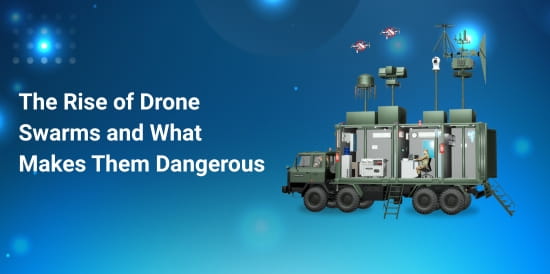
In the previous article, we covered the Detection of Drones which explained about active and passive detection. This week we shall read more on RF Detection & how it works to detect UAV’s effectively.
Since UAVs need to be controlled by a Ground Control Station (GCS) through a Radio Frequency (RF) command up-link, RF detection holds promise as a cost effective way of monitoring UAVs especially on account of advances in Software Defined Radio (SDR) technology.
The UAV too is continuously communicating with the GCS on its down-links either for updating its positional data from its on board Global Navigation Satellite System or for transmitting video from its cameras. Detection of the down-link from the UAV to the GCS is somewhat easier, since the UAV is likely to be closer to the detector than the GCS. Further, the command up-links are likely to use some method of spread spectrum such as Frequency Hopping (FH) or Direct Sequence (DS) to build in resilience to interruptions, which could be either intentional or unintentional, in the command link. Down-links especially the First Person View (FPV) link normally use Orthogonal Frequency Division Multiplexing which are relatively easier to detect.

For instance, during the recent conflict in the Gaza Strip, the Israeli Iron Dome system which uses RADAR based detection; only brought down one Hamas drone while five drones were shot down by the Israeli Air Force[i]. In these situations, RF detection holds the most promise as a cost effective means of monitoring drone activity. This solution is offered by vendors such as Rohde & Schwarz[ii], and Aaronia[iii]

In today’s day and age, drones have become a very common sight in the skies. Inadvertently, they are also used for the wrong reasons. As technology evolves, so do the types & application of unmanned aircraft backed with the latest and greatest technology. Drones are not just limited to military use; they’re now systems for fun toys for the average consumer and businesses are using them for security and surveillance. They can be used to spy on a house or office, fly into secure facilities and carry contraband items which are a threat.
Thus, one of the important requirements would be to keep costs of detection systems down since drones are low cost threats and the limitations of detection at extended range would require a larger number of systems to provide effective area coverage. In the upcoming article we will understand more on Radar based drone detection.
Stay Tuned!
Citation:
[i] https://www.israelhayom.com/2021/05/26/what-do-we-know-about-hamas-drones/
[ii] R&S®ARDRONIS-I identification package | Rohde & Schwarz (rohde-schwarz.com)
[iii] www.aaronia.com




